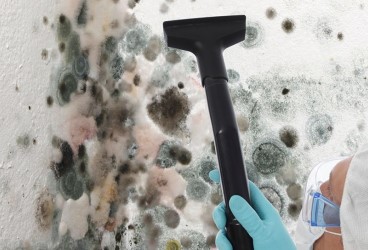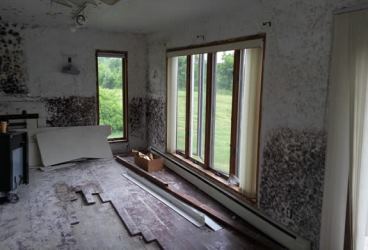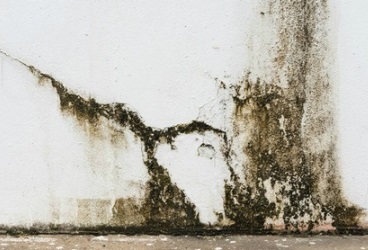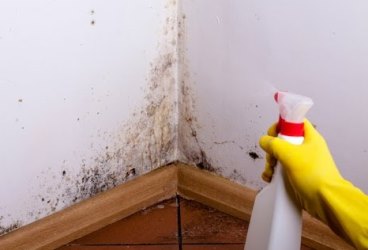
Can Mold On Walls Make You Sick?
Most people see molds as something harmless; yes, it does look unpleasant but overall, they don’t see it as a risk. Sadly, this isn’t true. These odorous, ugly, hard-to-get-rid-off fungi can pose a serious threat to one’s health and safety if left unaddressed. The challenging part is – it grows and spread in as fast as 48 hours, therefore, it should be resolved at the soonest possible time by calling a Water Damage Pro. So whether you suspect your place to be affected or you’re seeing it literally on your wall, you need to know what molds are about and how you can get rid of it, now! What Is A Mold? A mold is a type of fungi that can either be beneficial or dangerous. Penicillin, for instance, is created out of some kind of mold. This life-saving antibiotic is still used until now. Meanwhile, there are types of mold that can be hazardous to one’s health. Normally, it grows in areas where moisture and/or humid is present. It feeds on almost anything such as paper, wall, or wood. A small leak of water can start a serious mold problem, therefore, it should be addressed immediately. Mold spores are very tiny that it can’t be seen by a naked eye; since they are very light, they become airborne and can be inhaled easily by people near the infected area. Almost anyone can be affected easily, especially the children and elderly. Meanwhile, if you’ve got a severe problem with molds, you can still be a victim no matter how strong you think you are. Your pets may also be badly affected. Normally, a simple irritation happens when the area you’re living in has molds but it can turn into something serious or even fatal in some cases. Some of the symptoms of mold-related illness include the following: Asthma Coughing Depressed immune system Fatigue Pneumonia and bronchitis Rashes Sneezing Sore throat Considering this, it’s important to resolve your dilemma with molds in the soonest possible time. You can kill mold in your walls using soap and water, white distilled vinegar, or by using chlorine bleach. On the other hand, if you think you cannot resolve it on your own or if you want to be sure about how bad your mold problem is, it’s best to call for assistance. There are a lot of mold removal companies in San Diego alone and you can surely find the right service provider. These companies are manned by mold removal experts to clear infested areas. Meanwhile, if you think you’re suffering from a mold-related illness or you’re experiencing any of the symptoms above, you should see a medical expert for diagnosis and treatment. However, you cannot guarantee that you will recover from the sickness unless the entire mold is removed from your home or office. Mold removal experts normally offer mold remediation – or the process of getting rid of molds. Normally, this disturbs the mold causing them to dwell in the air. For…

Does Bleach Kill Black Mold?
Black mold infestation, along with the other types of mold, is simply devastating. It’s ugly, odorous, and risky to one’s health and safety. The worst part is that it grows and germinates easily. All it requires are moist or humid and organic food. It comes in different shapes and hues, like blue, black, white, green, or a combination of these colors. It affects areas that are often damp and moist, such as the basement, ceiling tiles, bathroom tiles, damped wood, shower heads, bathtubs, and a lot more. However, what makes mold growth alarming is not only the unpleasant sight it brings to one’s home but the medical problems it may cause. The toxic it produces can get airborne and it spreads easily all over the area, making their way into the people and pets living nearby. Some of the mold-related conditions include asthma, skin irritation, respiratory problems, and worse – death. One of the common solutions to address this concern is through the use of household chlorine bleach. But does bleach really kill black mold? Does Bleach Really Work In Killing Molds? Bleach is one of the most popular disinfecting and sanitizing chemical used in homes and other establishments. As a potent oxidizer, it is known as an effective solution to get rid of certain types of bacteria. While it is true that it helps in killing molds on certain areas, such as countertops, bathroom tiles, bathtubs, and glass-surfaces, it cannot penetrate underneath areas that are infected with molds. According to the experts, this harsh, corrosive chemical can only work on non-porous surfaces – not on layers that are porous – such as wood or drywall. Basically, molds do not just grow on the areas above but also underneath, which, sadly, bleach cannot penetrate. As the bleach stays on the surface, it makes the problem worse because the water only gets absorbed deeper. Although the mold is eliminated from the surface, it comes back in just a few days because the root is still implanted beneath. Using bleach to kill black mold is deemed effective as it gets rid of the mold and its moldy color; however, it doesn’t mean that it has been completely removed the mold for good. That being said, is it still recommended to use bleach when mitigating this fungus? If you’re aiming to remove mold in non-porous surfaces, bleach is still a feasible option. However, since it is a harsh chemical, the Environmental Protection Agency (EPA) says otherwise as it is risky to one’s health and property. First, it is a corrosive chemical which damages the surface where it is applied. The fumes produced are also harmful to the lungs and esophagus lining; thus it’s recommended to wear a face mask when using it. It can cause irritation to the skin and eyes so it’s best to use gloves and eye goggles. When not attended immediately, bleach can cause further damage to your eye tissues. It’s also worth considering using bleach only as an option,…

How Long Does It Take For Mold To Grow
A small leak or excess water always leads to trouble in every home. It may destroy electronics, causes slips and accidents, ruin carpeting, clothing, or furniture, and promote the growth of mold – which, by the way, is another huge problem. In most cases, molds can be addressed easily; however, if it’s been ignored for a period of time, it might require professional assistance to be resolved. What Happens After Water Damage The damage left by a burst pipe, flood, or leaky roof may not be huge, but that doesn’t that you should stop worrying as this may result in a mold problem. After all, it only takes a small amount of water or moisture to grow and start spreading easily. Mold spores exist everywhere and it doesn’t need much to grow. Humid, moisture, and “organic” food – such as wood – are enough for it to survive. Other porous organic materials that contribute to the growth of these fungi include paper product, drywall, paint, and insulation. The worst part is that it won’t take a long time for the mold to develop and start wrecking your property; in fact, it only needs 48 hours to become visible and damaging. The good news is: there are still a couple of things you can do to remove mold, or at least eliminate, the moisture or humid before the mold develops. To start with, you need to know two things: 1. how long does it take for the mold to grow and 2. how soon will it damage your walls, ceiling, and household items. Under ideal condition (which means there are moisture and organic food), it takes only 24 to 48 hours for the mold to grow and spread. For the mold to populate, it only needs 3-12 days and 18-21 days to become visible. However, this may vary according to the types of mold and the things present in your home, such as the amount of moisture present, the types of surfaces and materials nearby, temperature, etc. Nonetheless, the longer it is neglected, the bigger the chance for the mold to grow and germinate. Mold growth is a big problem and it requires only a few hours to spread. As soon as the mold spore settles on a moist or wet area and feeds of the organic food found on the porous surface, it spreads and damages the material it is attached to. Since it is light, it is airborne and emits thousands of spores that colonize the entire property. Therefore, it’s important to act as fast as you can to dry your home or office. This is the only thing you can do to prevent the mold from infecting your property. Meanwhile, there are other ways on how you can keep the mold from growing after water infiltration, such as: Extract excess water and open the door and window in your home or office. This will let the air flow and dry the premise. Make sure that you will put…

How To Get Rid Of Black Mold In Shower
Molds are not just unpleasant to look at; it’s also odorous and bad for one’s health and safety. However, it is present in almost every home and office and it only needs a couple of things to grow and spread. One of its favorite places is the bathroom – the area where water and moisture are likely to be present! Molds can be easily spotted in the bathroom walls and bathtub, and you can remove and place the mold caulking if you own the place. However, if you live in an apartment that would not be the best option as it is expensive, time-consuming, and may still require permission from the homeowner. However, you can opt for a “quick fix” that is almost as effective, simple, and affordable. All you need is to have the right tools and supplies and of course, patient to remove that musty fungus. Materials Needed to Get Rid Of Black Mold In Shower Bleach Bowl Cotton balls or cotton coil Gloves Water Face mask (optional but recommended) Aside from the mold that may cause an allergic reaction, it’s important to use protection (gloves and face mask) to protect yourself from bleach – which is a harsh chemical, to begin with. Steps To Follow When Removing Mold In Shower Start by wearing a face mask and gloves. Be sure to keep your window/s and door open before you start. In a bowl, mix water with a small amount of bleach. Soak cotton balls or cotton coils in the bleach-water mixture. Apply the soaked cotton balls directly to the mold in your bathtub and/or shower. Make sure to cover all the areas with soaked cotton balls, including the walls and window ledges. Since the cotton is wet, it will be easy to stick it vertically. Leave the area for at least 2 hours or so, until the mold is completely removed. Close the bathroom door as you leave. After 2 hours, check the area to see if the mold has been completely removed. If not, repeat the process and wait for another hour. However, if the mold is gone, you can remove the cotton balls and throw it into a trash bag/ trash bin. Be sure to wear gloves and a face mask when doing this to protect yourself from the chemical. Leave the area to air dry. If you want to get rid of the smell faster, you can rinse it water. While bleach is one of the common solutions when it comes to mold-related problems, it’s neither the only nor the best option you have. The chemical is only effective on non-porous materials like glass, bathtubs, countertops, and bathtubs; however, it won’t help you deal with the surface underneath. Also, since it is harsh and corrosive, it’s best to check out other safer alternatives when getting rid of mold in your bathroom. Some of this includes vinegar, borax, ammonia, baking soda, detergent, tea tree oil, hydrogen peroxide, and grape seed extract. Killing Mold Using Vinegar One…

How To Get Rid Of Mold In Basement
Mold – a four-letter word that is not only unpleasant to look at but also hazardous to one’s health and safety. This common household problem also emits a foul, musty odor and can be a sign of something more problematic – water leaks. One of the common areas in your home where mold growth is likely to occur in the basement. This article will help you resolve the mold problem on your own. It covers two basic steps to follow: moisture control and mitigating the mold. What Causes The Growth Of Mold? Simple water leaks can already a cause the growth of mold in your basement, especially when it’s been neglected for a long period of time. It doesn’t need much to go on and spread and it feeds on almost anything it is attached with such as the wood. Normally, it appears on floors, ceiling, and walls of homes and even offices. Mold and mildew are often confused as the same thing; basically, it’s true, however, when you refer to mildew, these are minor mold problems that can be usually found in the bathroom. Molds, on the other hand, can be severe and may cause health problems such as asthma, allergic reactions, respiratory problems, and even death. Its common victims include young ones, elderly, and anyone with a weak immune system. The difficulty of removing a mold from one’s home depends on the severity of the mold; some can be resolved on your own while others may require professional assistance. Therefore, it’s best to mitigate it in the soonest possible time. Some molds can be spotted easily; it appears in various shapes and colors such as green, black, blue, white, or combination of these colors. Control Moisture Unfortunately, there’s really no way to eradicate mold and mold spores indoors but there are a handful of solutions to control it. One of which is to resolve water problems, such as leaks. Frequently check all the areas in your home, including the basement, for any sign of leaks. Clean and dry these areas immediately to avoid mold growth. It’s also necessary to keep your property well-ventilated to reduce indoor humidity. Air conditioners and dehumidifiers also help in preventing a room to become warm and stagnant. Another way of controlling moisture is to insulate roofs, windows, pipes, and exterior walls. This is important so as to avoid condensation, which eventually leads to moisture formation and molds. Getting Rid Of Mold In The Basement Now that you know how to control molds from developing in your home, the next thing you should consider is removing it from your basement. Water infiltration causes the growth of these fungi so it’s important to resolve this immediately. While some molds can be spotted easily, there are cases when it is not visible and can only be determined by its musty smell. If you suspect a bigger mold problem or you’re not certain what to do, it’s best to leave it to the expert. Otherwise, you can…

